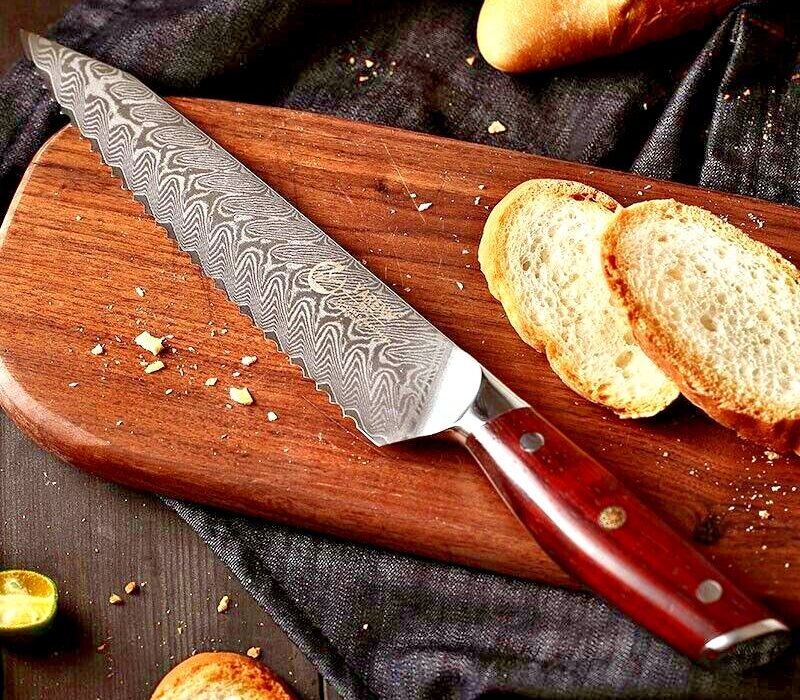In the world of culinary arts, the importance of quality kitchen tools cannot be overstated. Among these tools, the bread knife holds a special place. Whether you’re a professional chef, a passionate home baker, or simply someone who loves a good slice of bread, understanding what makes a good bread knife can make a tremendous difference in your kitchen experience. In this article, we’ll delve into the key qualities that define an excellent bread knife and why it matters so much.

Understanding the Bread Knife: A Crucial Kitchen Tool
A bread knife is designed specifically for slicing bread, cakes, and other baked goods. Unlike regular knives, bread knives feature a serrated edge that allows them to cut through crusty and soft bread without squishing it. The serrations grip the bread crust, making precise cuts possible.

Key Features of a Good Bread Knife
Serrated Edge
The most distinctive feature of a bread knife is its serrated edge. This technology allows the knife to cut through tough crusts while preserving the soft interior of the bread. The serrations act as small teeth that grip the crust, reducing the risk of slipping and ensuring clean, even slices.
Blade Length
A good bread knife typically has a blade length of around 8 to 10 inches. This length provides enough reach to cut through large loaves of bread effortlessly. A longer blade also helps maintain stability and control while slicing.
Material and Durability
The material of the blade plays a significant role in the knife’s performance. High-quality stainless steel is the preferred choice for bread knives due to its durability, corrosion resistance, and ability to retain a sharp edge over time. A well-made bread knife should withstand frequent use without losing its cutting efficiency.
Handle Design and Comfort
The handle of the bread knife should be ergonomic and comfortable to hold. A good grip ensures better control and reduces the risk of accidents. Look for handles made from materials that provide a secure and non-slip grip, even when hands are wet.

Why a Good Bread Knife Matters
A good bread knife contributes to a better kitchen experience in several ways:
Preserving Texture
Using a well-designed bread knife helps maintain the texture of your bread. Instead of squishing or tearing the loaf, a bread knife ensures clean cuts that preserve the integrity of each slice.
Efficiency and Precision
A quality bread knife makes the slicing process more efficient and precise. Whether you’re cutting a crusty artisan loaf or a delicate cake, the serrated edge and proper blade length provide the necessary control to achieve the desired results.
Safety and Control
Using the right tool for the job enhances safety and control in the kitchen. A bread knife’s serrations reduce the risk of slipping, making it safer to use compared to using a regular knife for the same task.
Prolonging Freshness
By making precise cuts with a good bread knife, you can avoid excessive crumbling and keep your bread fresh for longer. Clean slices also contribute to better presentation when serving bread to guests.

Choosing the Perfect Bread Knife
Consider Your Baking Needs
The ideal bread knife depends on your specific baking habits. If you frequently bake large artisan loaves, opt for a knife with a longer blade. For smaller loaves or cakes, a shorter blade may be more suitable.
Test the Grip
When choosing a bread knife, hold it in your hand to ensure the handle feels comfortable and provides a secure grip. A well-balanced knife reduces strain on your wrist during cutting.
Check Reviews and Recommendations
Reading reviews and seeking recommendations from fellow bakers or chefs can provide valuable insights into the performance and durability of different bread knives. Look for knives that consistently receive positive feedback for their cutting ability and longevity.
Price vs. Quality
While price can be an indicator of quality, it’s essential to balance your budget with the features you need in a bread knife. Investing in a high-quality knife can enhance your baking experience and last for many years.
Caring for Your Bread Knife
Proper Cleaning
Always hand wash your bread knife after use. Avoid dishwasher cleaning, as it can dull the blade and damage the handle. Use mild soap and warm water to remove any residue, and dry the knife thoroughly before storing.
Regular Sharpening
Maintaining the sharpness of your bread knife is crucial for optimal performance. While serrated knives don’t require sharpening as frequently as straight-edged knives, they still benefit from occasional honing. Use a specialized serrated knife sharpener or seek professional sharpening services.
FAQs
What makes a good bread knife different from a regular knife?
A good bread knife features a serrated edge that allows it to cut through tough crusts without squishing the soft interior. Regular knives have smooth edges that can crush and tear bread.
How often should I sharpen my bread knife?
While bread knives don’t need sharpening as frequently as straight-edged knives, it’s best to hone them occasionally to maintain their performance. Sharpening once or twice a year should suffice for most home use.
Can I use a bread knife for other tasks?
While specialized for bread, a bread knife can also be used for cutting cakes, tomatoes, and other soft foods with tough exteriors. However, it’s advisable to reserve it for its primary purpose to prolong its lifespan.
As an Amazon Associate, I earn from qualifying purchases.


